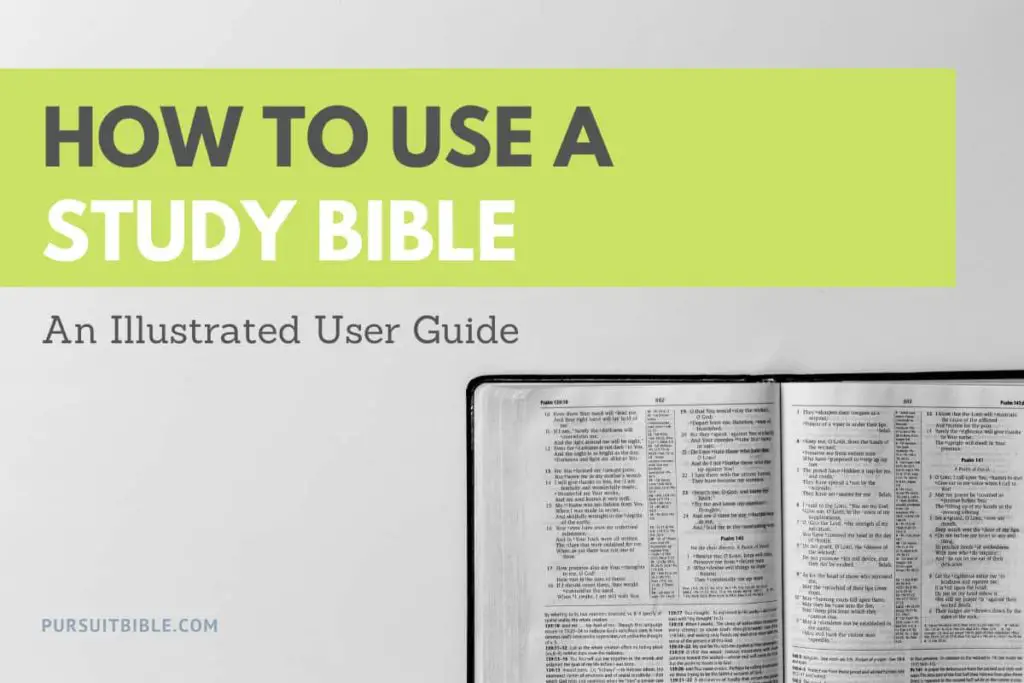
A Study Bible is a great resource to help take you deeper into your study of the Bible. It combines all the most used resources in one-volume. I remember the excitement of getting my first Study Bible more than 30 years ago. But, it can also be a bit confusing and even intimidating at first to use one because there’s so much in there.
Let’s go through the major tools in a Study Bible so you can study the Bible with confidence. I’ll be using the ESV Study Bible (Link to Amazon) in the photos and examples. Most Study Bibles will have similar tools although the layout might be different.
For those just starting out, I recommend the CSB Tony Evans Study Bible (You can check the reviews on Amazon) instead because it has a more devotional approach along with solid Biblical scholarship.
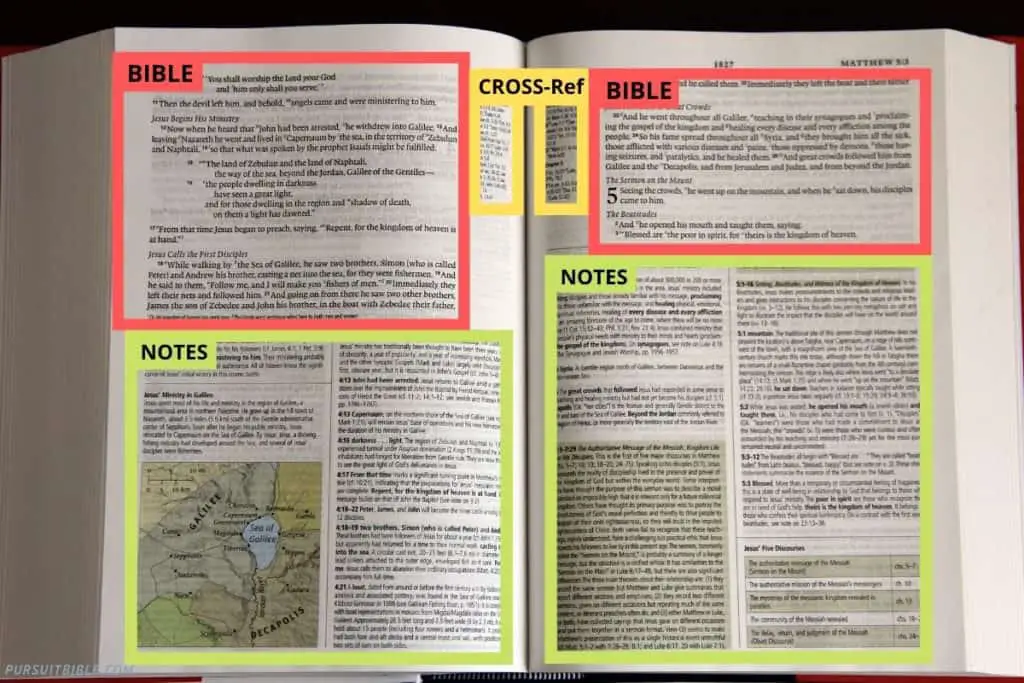
Table of Contents
- 1. How to Use Cross-References in a Study Bible
- 2. How to Use the Notes and Commentary in a Study Bible
- 3. How to Use the Book Introductions
- 4. How to Use the Maps in a Study Bible
- 5. How to Use the Concordance in a Study Bible
- Enjoy the Journey and Encounter Jesus
1. How to Use Cross-References in a Study Bible
Cross-references connect the verse that you’re reading with other related verses in the Bible. Finding these other passages in the Bible can shed light on what you’re reading and studying. It’s helpful to look at the verse from the larger context of the book that you’re reading or from what the rest of the Bible says about the topic.
When you look up cross-references, you can look for common themes or patterns. You might notice that there are exceptions that emphasize different aspects of the topic you’re searching.
These cross-references are usually found in the margins of a Study Bible. Sometimes, they’re just below the text of the Bible.
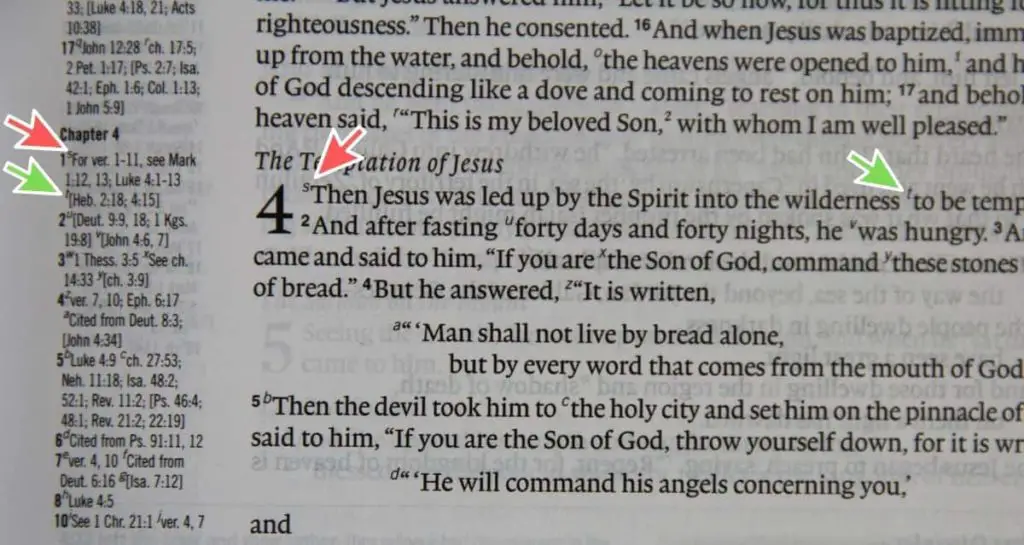
How do you use these? Let’s say you’re reading Matt. 4:1-11. As you begin reading in verse 1, you’ll see the small italicized letters in the text of the Bible. In the photos, there’s an “s.” Look at the cross-reference and under chapter 4, verse 1, you’ll find an “s.”
The “s” in the text points you to Mark 1:12, 13 and Luke 4:1-13. These are parallel passages in the Gospels. You can compare each account to see what it includes or emphasizes. You can pick up different details in each passage.
These parallel passages can shed new light on the passage that you’re reading. You can also read the different notes and cross-references on these parallel passages. One passage might lead to another and you might find yourself with several bookmarkers at different places in the Bible. This is when it gets fun!
Don’t feel limited to one passage in the Bible, but at the same time, don’t feel like you have to chase every rabbit trail.
Next, in the text, you’ll see a “t” before the phrase “to be tempted by the devil.” Go back to the cross-references and you’ll see that the “t” points you to Heb. 2:18; 4:15.
When you turn in your Bible to Heb. 2:18 and you’ll see that it talks about how Jesus suffered when He was tempted. This passage brings out the application that Jesus is able to help those who are being tempted because He went through these temptations too.
Next, if you go to Heb. 4:15, it brings out the idea that Jesus experiencing temptation is compared to the role of a high priest in the temple in the Old Testament. It also brings in the fact that Jesus never sinned, even though He was tempted.
At this point, you can go back to your original passage, Matt. 4, or if any of the topics that you found interest you, you can pursue those. If you want to pursue these at a later point, just circle these passages in the cross-reference section of Matt. 4, and you can continue your study next time.
There are so many possibilities! The ESV Study Bible has more than 80,000 cross-references in the Bible. As you progress in understanding the Bible, you’ll get more comfortable with the different parts of the Bible and you’ll begin to make the major connections on your own without the cross-references.
For now, know that these cross-references are there and you can go down this path anytime you choose to.
2. How to Use the Notes and Commentary in a Study Bible
The notes or commentaries on the text are written by various contributors to the Study Bible. These are the Bible scholars and teachers who provide notes and comments on the verses.
The text of the Bible is what we receive as God’s Word. The comments are the explanations written by people and they are different in each Study Bible since the contributors are different.
All Scripture is breathed out by God and profitable for teaching, for reproof, for correction, and for training in righteousness, that the man of God may be complete, equipped for every good work.
2 Tim. 3:16-17 (ESV)
Most Study Bibles bring together a broad range of Bible scholars and teachers so that it will be received by a wider audience. The most helpful comments and notes will describe any major differences in interpretation so that you can be aware of the various approaches.
The notes and comments are usually at the bottom of the page, sometimes in a different style font and size to contrast it from the text of the Scripture.
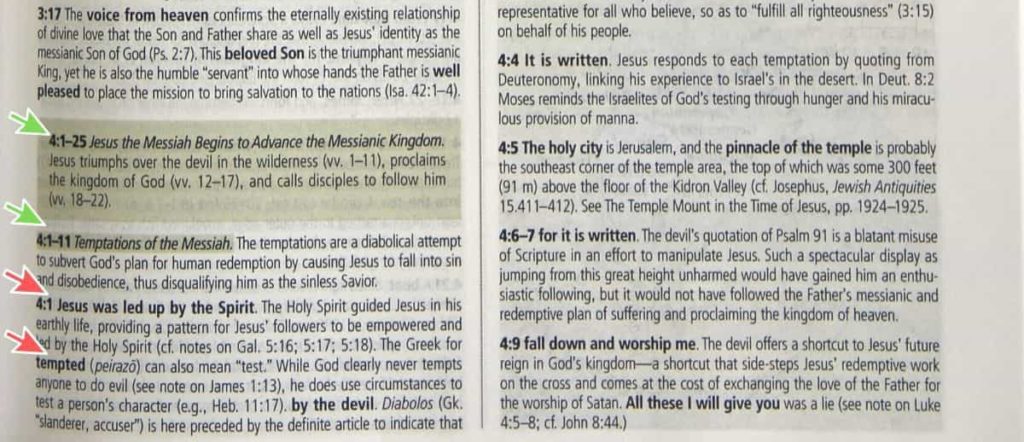
In the ESV Study Bible, there is a box that describes this major section of the book: Matt. 4:1-25 (first green arrow). You can combine this with the Outline in the Book Introduction, which we’ll look at later. This gives you the big-picture outline of where this fits in the book of Matthew.
In the example in the photo, you’ll see that there is a general comment or summary on Matt. 4:1-11 (second green arrow).
After that, you’ll find the comments on each verse. The phrase in bold is the phrase from the text of the Bible that is being commented on. For example, the first comment on Matt. 4:1 is on the phrase “Jesus was led up by the Spirit” (first red arrow). After the comments on that phrase, we go to the next bolded word or phrase, which is “tempted” (second red arrow).
Different Study Bibles are different in the numbers of notes that they have and the level of detail in the notes. As with all the tools in a Study Bible, they will be limited in number because of the amount of space each one would take up.
In the beginning, most people look at the notes a lot since they’re very accessible. As you progress in your study, the cross-references could take on more importance. That’s the beauty of a Study Bible. All the tools are there so you can flow from one type of study to another.
Also, in the notes and comments section, you’ll sometimes find relevant maps, charts, illustrations, or other helpful material.
In some Study Bibles, these extra resources are listed in one place, either at the beginning or end of the Study Bible. The ESV Study Bible has them listed at the end. Each one of these has cross-references and themes that you can pursue in your Bible study.
Depending on the Study Bible, you might find other features that highlight things like word studies, application points, and historical background. Some Study Bibles incorporate these into the notes and comments section and don’t put special design elements around them.
3. How to Use the Book Introductions
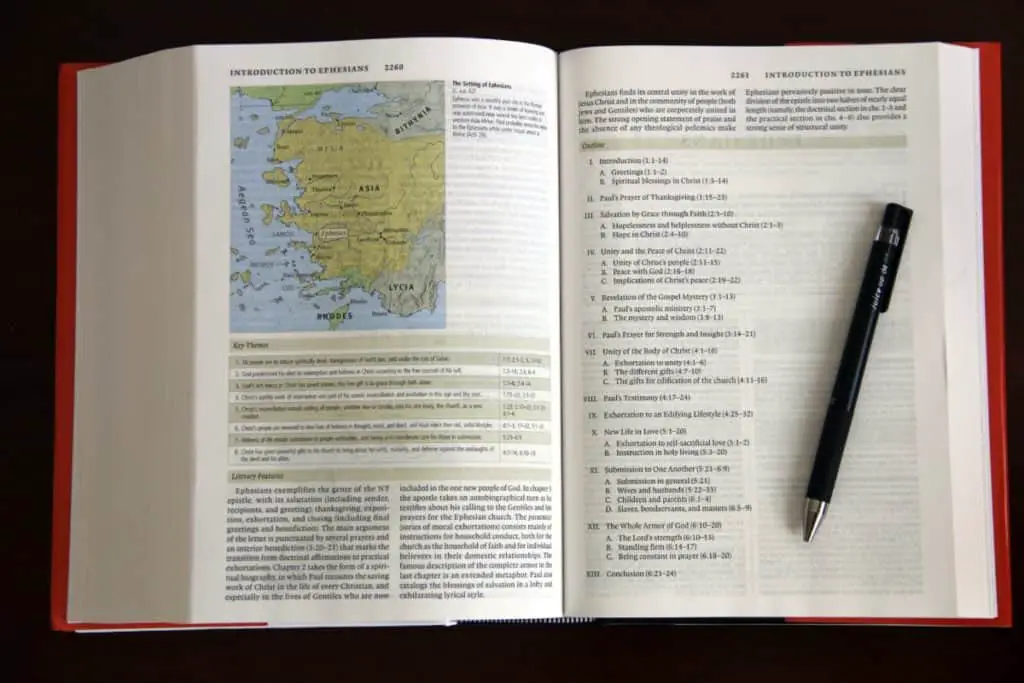
One of the key resources in a Study Bible is the introduction to each book of the Bible. These cover essentials such as author, recipients, the date the book of the Bible was written, the main theme(s), the purpose the book was written.
Some might include a timeline, maps, or charts that will help shed some light on the historical background. Most of the background information is straight-forward and doesn’t need that much explanation.
Many Study Bibles will also include an Outline of the book. These can be helpful in getting a grasp of the big-picture overview of the book. If you’re doing a book study, I would recommend making your own outline early on in your study and tweaking it as you dive deeper into the book.
My recommendation for the first reading of the book introduction would be to just aim for a general idea of the book. Get enough information to get started, but don’t get bogged down in the details.
As you read and study the actual text of the book of the Bible itself, plan on revisiting the book introduction again at a later time. A lot of the information will make more sense after you’ve spent some time reading the actual text of the Bible.
Reading a book introduction is especially helpful if you’re doing an in-depth study of a book of the Bible as opposed to studying a theme or topic in the Bible. Here’s an article in which I explain how you can do that: How to Study a Book of the Bible: 5 Step Guide With Examples (link opens in a new window).
For example, when you’re studying a book like Ephesians, learning about the background of Colossians can be helpful. Or if you’re studying the book of Ezra, reading the book introduction to Haggai and Zechariah could be helpful since both of these prophets prophesied during Ezra’s time to encourage and guide the people.
Also, look for other resources that supplement the book introductions. For example, if you’re reading one of the letters of Paul, there might be an article about the Pauline Letters in general. Or there could be articles or introductions to the letters that Paul wrote from prison.
Every Study Bible is different, so you might have to flip around in the Table of Contents to see if there are other resources that would be helpful in your Study Bible. If there are, take advantage of them. Also, most Study Bibles will have an introduction to the Old Testament and one for the New Testament. There might be one that gives an overview of the Bible.
Also, look for articles on specific sections of the Bible or genres of books. For example, the ESV Study Bible has articles on introduction to the Pentateuch (the first five books of the Old Testament), the Poetic and Wisdom literature, Prophetic books, Gospels and Acts, and the Epistles.
For example, if you’re studying the Psalms, after looking at the book introduction to the Psalms, read the Introduction to Poetic and Wisdom literature in the Bible. It might shed some light on how Hebrew poetry is different from poetry in the English language.
4. How to Use the Maps in a Study Bible
The best way to use a map is to put yourself in the story.
The best way to use a map is to put yourself in the story.
If you’re studying one of the Gospels and looking at the ministry of Jesus, find yourself on the map. What’s the terrain? Is it in the Northern region of Galilee where Jesus grew up or in the Southern area, closer to Jerusalem, the capital?
If you’re studying the missionary journeys of Paul because you’re in the book of Acts or one of the Epistles, find yourself on the map and imagine the journey that needs to take place.
If you’re studying the book of Exodus, Numbers, or Joshua, see the journey from Egypt to the Promised Land. Look at the direct route that they could have taken from Egypt to the Promised Land. Look at the area that they ended up wandering in for 40 years. Lastly, look at the river just before crossing into Jericho. This is where some of the tribes choose not to cross over into the Promised Land.
Most Study Bibles will have the standard maps like the land during the time of the Patriarchs, during Israel’s monarchy, during the time of Jesus’ ministry and Paul’s Missionary Journeys.
When you’re studying a book or story in the Bible, look at the Book Introduction and look for any maps, then glance at the back to see if there are larger maps that are related.
On their own, maps are not that accessible and can seem like random pictures. The maps only become useful when used together with the particular book or books that they correspond to. You’ll have to pair the maps with the book introductions or articles to get the most out of them.
5. How to Use the Concordance in a Study Bible
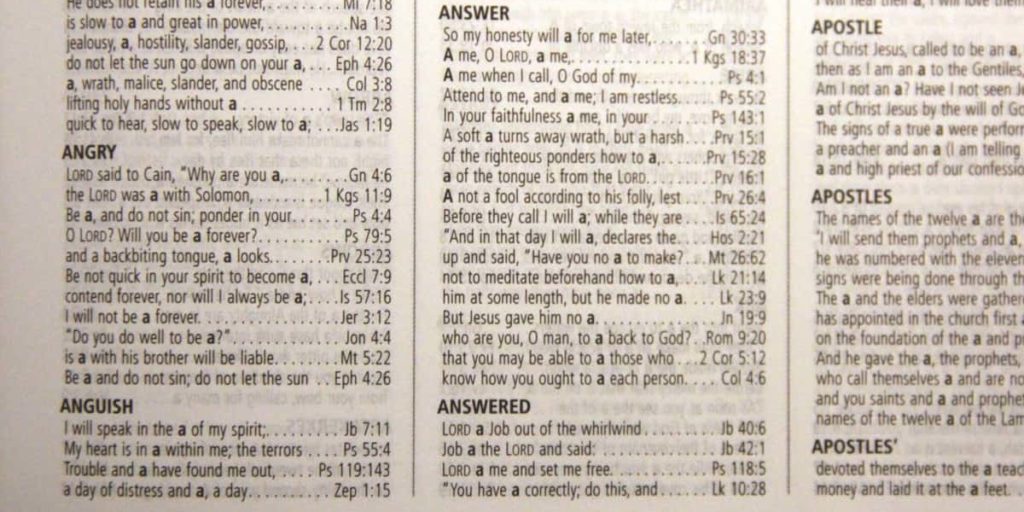
How to find Bible verses? A concordance or internet search can help you locate a certain word or verse in the Bible. Most Study Bibles will have some sort of Concordance or index in the back.
Some Study Bibles will have a more extensive Concordance than others, but keep in mind that these are all limited to major words from the most familiar and popular verses.
The New Strong’s Expanded Exhaustive Concordance of the Bible (link to Amazon), which is a very popular Concordance, lists many more words but is almost 2000 pages long! It’s a great resource for word studies but has way more information than would fit in a Study Bible.
With internet searches being just a few clicks away, the concordance isn’t used as much as it used to be. The concordance in the back of the Study Bible is still very helpful in narrowing down the choices. Since it would only list the most popular verses, you don’t have to wade through dozens of verses to find the one that you’re more likely to be looking for.
For example, searching for the word “anger” on ESV.org turns up 267 results. The concordance in the back of the ESV Study Bible lists 15 verses. If you’re trying to find a verse that you heard about anger, it’s most likely to be one of the 15 verses in the concordance.
Enjoy the Journey and Encounter Jesus
There is a bit of a learning curve to using a Study Bible, but I hope you’ll stick with it. The rewards are worth it! There’s a hunger in your heart to know God and learn His ways. It might start as a spark but commit to spending time in His Word and ask the Holy Spirit to help you. He’s a brilliant leader and He delights to bring glory to Jesus, the Living Word.
But he answered, “It is written, “‘Man shall not live by bread alone, but by every word that comes from the mouth of God.’”
(Matt. 4:4).
Subscribe to my newsletter for updates and encouraging content.
| Are you looking for new ways to study the Bible? You can use a Study Bible and use one of these: 11 Ways to Study the Bible: Methods, Techniques & Tips. In the article, I explore different ways to study the Bible for which a Study Bible could be very useful. |
If you’re looking for a thorough Study Bible, I recommend the one I used in the examples for this article: 1) The ESV Study Bible (link to Amazon opens in a new window), and 2) For beginners, the CSB Tony Evans Study Bible (You can check the reviews on Amazon) – it has more of a devotional approach along with solid Biblical scholarship.
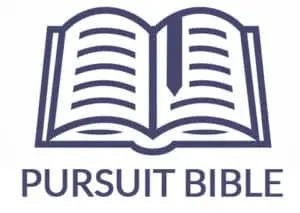

Like!! Great article post.Really thank you! Really Cool.
Thank you! I’m glad to hear it was helpful.
I’m adding this article to my bookmarked bible study tools! Thanks for your guidance 🙂
I’m so glad to hear it was helpful. Thanks! I hope God will take you deeper into His heart through His Word this year!
Hi David, thank you so much for all you do here. You have totally impacted me in a great measure. God bless you greatly.